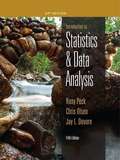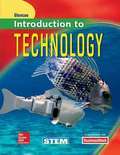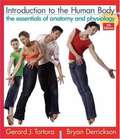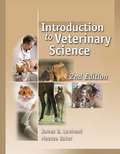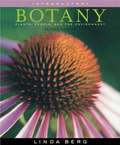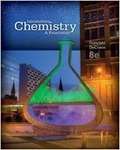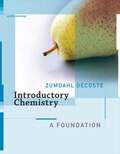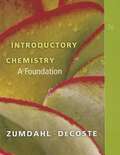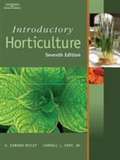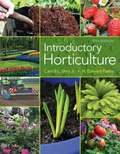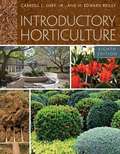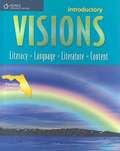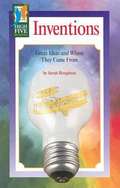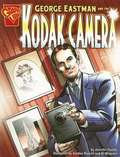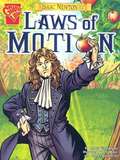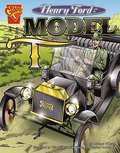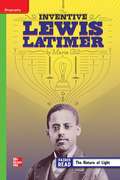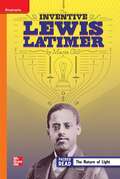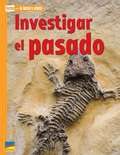- Table View
- List View
More NIMAC books are available at www.nimac.us. If you find your title in the NIMAC and not in Bookshare then please contact us to request it.
Introduction to Statistics and Data Analysis, AP® Edition
by Roxy Peck Chris Olsen Jay L. DevoreNIMAC-sourced textbook
Introduction to Technology
by Alan J. Pierce Dennis KarwatkaStudents will discover technology through project-based pedagogy with Glencoe's Introduction to Technology! Teachers and students are offered content that is driven by projects to facilitate hands-on understanding and learning, while academics are integrated in unit-based projects and chapter-based Technology Labs. Students are invited to play and "crack the code" with the Technology Time Machine game while learning the key content of the technology literacy standards. Prepare students for TSA competitive events with prep activities embedded throughout the content and end-of-chapter assessments. Rigorous academic content is fully supported, especially in math, geometry, and science, with STEM activities throughout. Point-of-use academic correlations are included to ease possible academic credit application. Teachers can meet Perkins mandates for academic excellence with extra activities in the Student Edition and in the Project Applications Workbook. Careers profiles, Tech Stars, Imagine This! and Eco Tech features enhance the content with relevant information and challenging activities.
Introduction to the Human Body: The Essentials of Anatomy and Physiology
by Gerard J. Tortora Bryan DerricksonNIMAC-sourced textbook
Introduction to Veterinary Science
by James B. Lawhead Meecee BakerAn introductory level text which begins with basic cell biology and tissue function, followed by the musculoskeletal, circulatory, respiratory, renal, digestive, reproductive, nervous, endocrine, and immune systems. Nutrition and diseases are covered in depth, including infectious disease principles, prevention, classification, zoonoses, and diagnosis. The final section addresses surgery. Appendices address decision-making and veterinary careers, and provide a glossary. Cases are discussed throughout, with color photographs, diagrams, and charts. (We contemn the 2005 copyright date in a book that is out in August 2003) Annotation (c)2003 Book News, Inc. , Portland, OR (booknews. com)
Introductory Botany: Plants, People, and the Environment
by Linda R. BergClear and engaging, Linda Berg's INTRODUCTORY BOTANY: PLANTS, PEOPLE, AND THE ENVIRONMENT helps you develop an appreciation of the diverse organisms we call plants, including their remarkable adaptations to the environment and their evolutionary and ecological relationships. Filled with fascinating feature boxes, intriguing chapter-opening stories, and other applied content, the text contains interesting and topical information that will pique your curiosity and help you succeed in your course. Berg shows you the many ways in which plants are fascinating in their own right, important for the existence of all life on Earth, and useful for humans in all aspects of our lives. INTRODUCTORY BOTANY: PLANTS, PEOPLE, AND THE ENVIRONMENT is beautifully and clearly illustrated and features a dynamic art program that helps you visualize even the most complex concepts.
Introductory Chemistry: A Foundation (Eighth Edition)
by Steven S. Zumdahl Donald J. DecosteImprove the problem-solving and critical thinking skills you need for success in your introductory chemistry course and beyond with 'Introductory Chemistry'. In-text examples help you learn what questions you should be asking yourself when solving problems and 'Chemistry in Focus' boxes describe the applications of chemistry.
Introductory Chemistry: A Foundation
by Steven S. Zumdahl Donald J. DecosteChemical reactions are covered early, to capture student interest, leaving more abstract material for later chapters. The authors explain chemical concepts by starting with the basics, using symbols or diagrams, and concluding by encouraging students to test their own comprehension of the solution. This step-by-step approach helps students develop critical problem-solving skills. Also, the accessible explanations and visualizations throughout the text motivate students and engage them in the material by helping them to connect abstract chemical principles to real-life experiences. The pedagogy includes chapter-opening discussions that introduce students to relevant applications andChemistry in Focusboxes that describe everyday applications of chemistry such as artificial sweeteners, foaming chewing gum, and fake fats. Current applications appear throughout the text with easy-to-understand explanations and analogies. New! Co-author Donald DeCoste brings experience as an author and as an instructor at University of Illinois, Urbana-Champaign to this new edition. New! HM Assess within Eduspace, Houghton Mifflin's Online Learning Tool, provides a diagnostic assessment tool to test students' understanding of core concepts and track student progress. New! A Multimedia eBook within Eduspace offers a one-stop resource for students to link from textbook content to study resources, including video lessons from Thinkwell, tutorials, flashcards, and ACE quizzes. New!Chapter 10, Energy, combines all the content on energy from Chapter 3 in the Fifth Edition with material on enthalpy, Hess's Law, the difference between the quality and quantity of energy, energy resources in the world, and entropy. Exercises and models such as worked-out examples, self-check exercises, and skill development boxes support the step-by-step problem-solving method. End-of-chapter material covers key terms, a summary of important facts, questions and problems arranged in matched pairs and keyed to chapter sections, additional problems that incorporate material from multiple sections, in-class discussion questions, and "Cumulative Reviews" that tests concepts from preceding chapters. The text builds and refreshes fundamental math skills such as scientific notation, rounding, and rearranging equations. In addition, Math Tips indicated by icons throughout, help students as they perform calculations. Math Review Tutorials on the Online Study Center provide practice for critical math skills. Basic Chemistry,6/e, in paperback, includes chapters 1-16 and provides basic coverage of chemical concepts and applications through acids and bases Introductory Chemistry,6/e, available in hardcover or paperback, includes chapters 1-18 and expands coverage with the addition of equilibrium, oxidation-reduction reactions, electrochemistry, radioactivity, and nuclear energy.
Introductory Chemistry: A Foundation
by Steven S. Zumdahl Donald J. DecosteThe Lab Manual for INTRODUCTORY CHEMISTRY: A FOUNDATION, 6th Edition, is a valuable tool designed to enhance your classroom experience. Lab activities, objectives, materials lists, step-by-step procedures, illustrations, review questions and more are all included.
Introductory Horticulture
by Carroll L. Shry Jr. H. Edward ReileyProviding the most up-to-date coverage of basic principles and methods of practical application, INTRODUCTORY HORTICULTURE, 9e, offers many avenues to explore the horticulture field and remain on the cutting-edge of the industry. Extremely student friendly, the text fully engages you within the learning experience through vivid imagery, a variety of activities, step-by-step procedures, and additional resources encouraging further exploration. The Ninth Edition emphasizes organic and sustainable farming methods, introduces new and emerging technology, and focuses on organizations and career development paths relevant to budding horticulturists. Through extensive full-color visuals, current information, and engaging activities, this all-new edition ensures success within a horticulture course - and well beyond.
Introductory Horticulture (8th Edition)
by Carroll L. Shry H. Edward ReileyINTRODUCTORY HORTICULTURE, EIGHTH EDITION, is the definitive text for horticulture science. Written in a concise, easy -to -read and logically organized manner, this text covers trend changes in the agricultural industry, principles in landscaping, business operations, and GIS uses in the landscape green industry. INTRODUCTORY HORTICULTURE, EIGHTH EDITION allows teachers to measure their students' progress with competencies, and the highlighted key terms and self evaluations keep the student focused on what they should learn and retain.
Introductory Physical Science
by Uri Haber-Schaim Peter Gendel H. Graden KirkseyNIMAC-sourced textbook
Introductory Visions: Literacy, Language, Literature, Content
by Jill Korey O'Sullivan Christy M. NewmanVisions Intro is a highly motivating beginning year course that takes students from pre-literacy and school survival to basic academic skills in listening, speaking, reading, and writing. It provides a seamless transition to Visions A. The carefully designed wraparound Teacher Edition contains a wealth of strategies from teacher modeling to direct instruction for beginners.
An Invention That Made a Splash (Fountas & Pinnell Classroom, Guided Reading)
by Erica CampbellSliding on a Slip ’N Slide is a fun way to cool down on a hot summer day. But the Slip ’N Slide is more than just a great toy … it's also an interesting invention story.
Inventions: Great Ideas and Where They Came From
by Sarah HoughtonHighlights inventions and inventors throughout history and discusses why people invent and the steps in the inventive process.
Inventions and Discovery: George Eastman and the Kodak Camera
by Jennifer Fandel Gordon Purcell Al Milgrom Mandy RobbinsIn graphic novel format, tells the story of how George Eastman developed the Kodak camera, and how this company changed the way people captured the moments of their lives.
Inventions and Discovery: Isaac Newton and the Laws of Motion
by Andrea Gianopoulos Phil Miller Charles Barnett Tom AdamsonTells the story of how Isaac Newton developed the laws of motion and the law of universal gravitation. Written in graphic-novel format. <P><P> <i>Advisory: Bookshare has learned that this book offers only partial accessibility. We have kept it in the collection because it is useful for some of our members. Benetech is actively working on projects to improve accessibility issues such as these.</i>
Inventions and Discovery: Henry Ford and the Model T
by Michael O'Hearn Phil Miller Keith Wilson Charles Barnett Christopher HarboTells the story of Henry Ford, along with his invention, the popular Model T automobile.
Inventos antiguos: Adelantados a su época (¡Arriba la Lectura!, Level T #34)
by Teresa Turner John FrancisLa gente lleva mucho tiempo inventando maneras de responder a los desafíos de la vida diaria. La gente del pasado tenía muchas de las necesidades básicas que hoy día resolvemos con inventos modernos. Encontraban maneras inteligentes de hacer las cosas más fácil y rápidamente. ¡Te sorprenderá saber lo avanzados que eran algunos de esos inventos! NIMAC-sourced textbook
Investigate Matter (Inspire Science, Grade 5 #Unit 1)
by McGraw-Hill EducationNIMAC-sourced textbook
